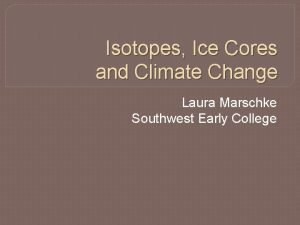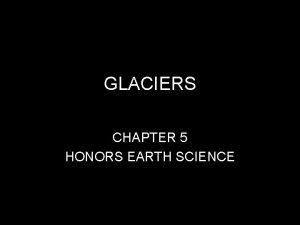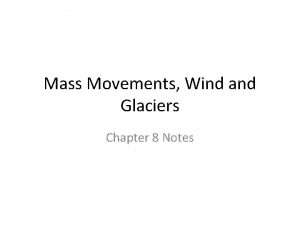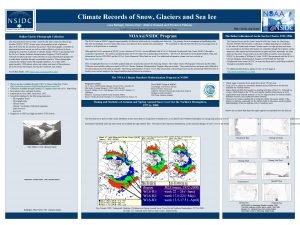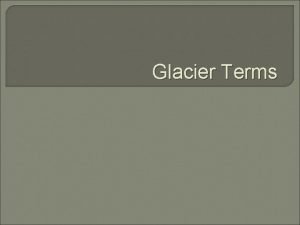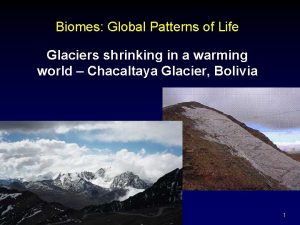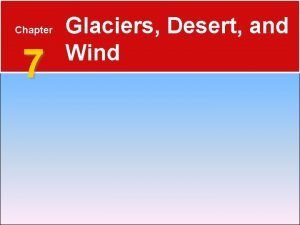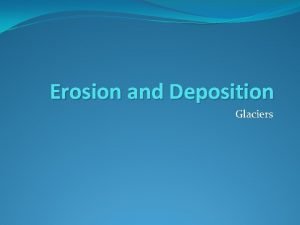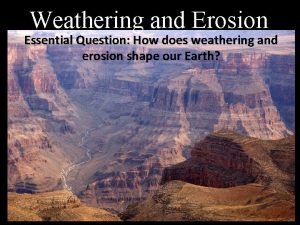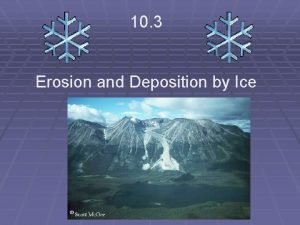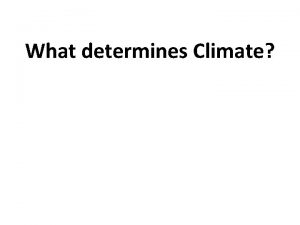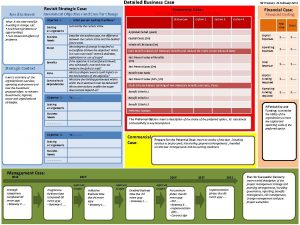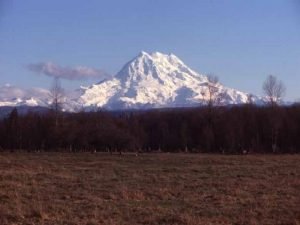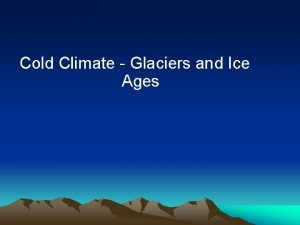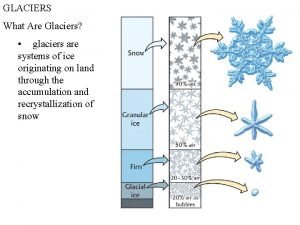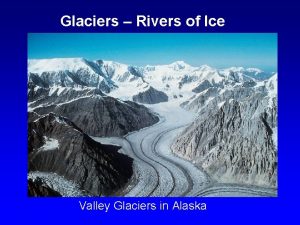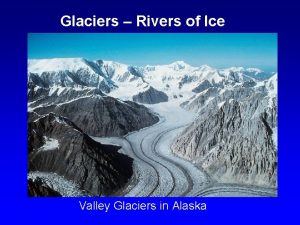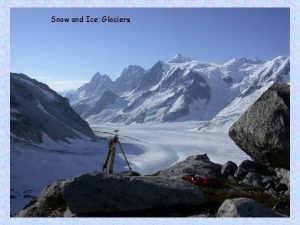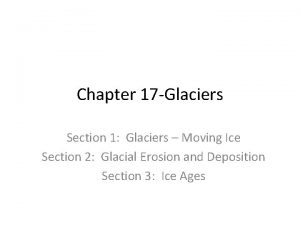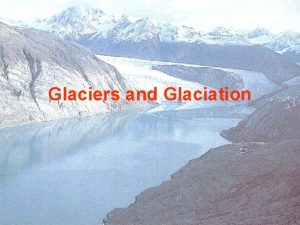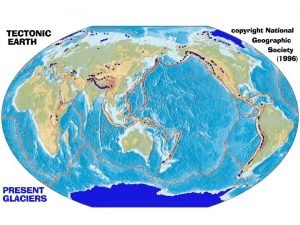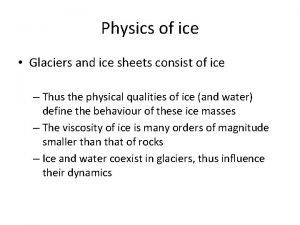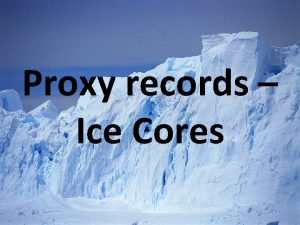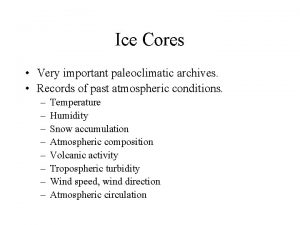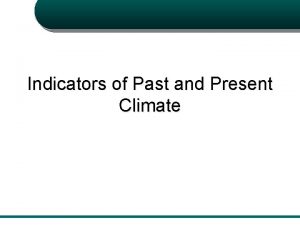Glaciers as records of climate Ice cores Detailed






















- Slides: 22

Glaciers as records of climate • Ice cores: – Detailed records of temperature, precipitation, volcanic eruptions – Go back hundred of thousands years

Past climate reconstructions • Instrumental records – Global air temperature: limited records • Proxy records of climate – “proxy” = a measure of climate conditions of the past – clues such as temperature, precipitation – EX: ICE-CORES

Global temperature- instrumental record

Global temperature- reconstructed

Methods of Dating Ice Cores • Counting of Annual Layers – – Temperature Dependent Marker: ratio of 18 O to 16 O find number of years that the ice-core accumulated over Very time consuming; some errors • Using volcanic eruptions as Markers – Marker: volcanic ash and chemicals washed out of the atmosphere by precipitation – use recorded volcanic eruptions to calibrate age of the icecore – must know date of the eruption


How do we reconstruct past climate from ice cores? • Oxygen Isotope analysis: – Examining type of water isotopes contained in ice – Gives clues about temperature at time of deposition

Isotopes Defined Isotope = atoms of the same element with a different number of neutrons (different mass) Example: Oxygen Isotopes Neutr Nam Electr Proto on s e ons ns Abund anc e 16 O 8 8 8 99. 76% 18 O 8 8 10 0. 20%

Stable Isotopes 16 O (Light Element) 18 O (Heavy Element) Chemical and Biological processes can sort the light elements from the heavy elements Fractionation Change in d 18 O value

Oxygen isotopes • Three isotopes: 18 O, 17 O and 16 O • Important isotopes: 18 O and 16 O • Modern 18 O/16 O ratio: • 1: 500

Isotopic change • Evaporation: lighter 16 O evaporates more easily from a water body resulting atmospheric H 2 O vapor is poorer in 18 O than oceanic water • Condensation: heavier 18 O are precipitated faster than lighter 16 O; • So: coldest snow is lightest (less heavy 16 isotopes, more lighter O isotopes) 18 O

Evaporative Fractionation Water vapor d 18 O? Precipitation will be depleted in 18 O relative to the standard (ocean water) Negative d 18 O


18 O/ O ratio: “delta 18 O” 16 • Stable isotope ratios are expressed as parts per thousand (per mil – ‰) relative to a standard 18 • Ratio expressed as deviation of O from the Standard Mean Ocean Water ratio (SMOW)

Delta O 18 and temperature • Temperature affects 18 O/16 O ratio: – colder temperatures more negative values for the delta 18 O – warmer temperatures delta 18 O values that are less negative (closer to the standard ratio of ocean water)

Delta 18 O and temperature

Seasonal variations • Summer (warmer) and winter (colder) periods in glacial ice can be observed as long as the delta 18 O ratio is locked into the ice


Continental effect

Altitudinal effect • As water molecules travel up on an ice sheet water changes from vapor to liquid 18 O is precipitated first • So: ice on the top of the glacier has less 18 O than at the base of the mountain

How far back do records go? • Greenland: the last 100, 000 years • Antarctica: record going back 400, 000 years has been reconstructed

Temperature reconstructed from Greenland Ice core
 Laura marschke
Laura marschke Morraine glacier
Morraine glacier Minnesota glaciers map
Minnesota glaciers map Chapter 8 mass movements wind and glaciers
Chapter 8 mass movements wind and glaciers Nsidc glaciers
Nsidc glaciers Glacier terms
Glacier terms Metamorphic rock
Metamorphic rock Bolivia glaciers
Bolivia glaciers Chapter 7 glaciers deserts and wind
Chapter 7 glaciers deserts and wind Is a valley
Is a valley Glaciers cause erosion by abrasion and
Glaciers cause erosion by abrasion and How can a glacier deposit both sorted and unsorted material
How can a glacier deposit both sorted and unsorted material Climate change 2014 mitigation of climate change
Climate change 2014 mitigation of climate change The three kinds of temperate marine climates all have
The three kinds of temperate marine climates all have Clear ice vs rime ice
Clear ice vs rime ice Nick czernkovich
Nick czernkovich Riddle ideas
Riddle ideas Detailed drawing example
Detailed drawing example Detailed business case
Detailed business case Feasibility analysis matrix
Feasibility analysis matrix Characteristics of dss in mis
Characteristics of dss in mis What is a range card
What is a range card Jis drawing standard
Jis drawing standard
